The Bundesliga teams started relying more and more on young coaches, and this has transformed the league from head to toe, making it one of the most exciting to watch.
There are a few clubs that confidently appointed some of the youngest and most innovative coaches around.
One of them are Werder Bremen, who in 2017 trusted the then 35-year-old Werder Bremen II coach, Florian Kohfeldt.
He has shown a clear vision for the team’s style of play and proved that his approach is flexible and can adjust to many different opponents.
The team has been wandering in the mid-table ever since, unfortunately, not being able to perform to their potential.
The German Football Association (DFB) named Florian Kohfeldt its Coach of the Year for 2018.
He improved the team’s performance and lifted them out of the relegation zone, and they finished 11th in the 2017/18 season.
The next season
, Werder reached eighth place but saw their top goal scorer, Max Kruse (11 goals), leave, which left many questions aboutwhether they would find a good replacement.
They did find a way to replace him, but despite their solid attack yet again, they allowed some defensive downgrades, and they are close to seeing their worst defensive record under the 37-year-old.
This tactical analysis aims to show Kohfeldt’s vision and tactical approach in the Bundesliga and what’s the team’s potential going forward.
Werder Bremen Lineup
Goalkeepers: Jiří Pavlenka; Stefanos Kapino; Luca Plogmann;
Defenders: Michael Lang; Ludwig Augustinsson; Miloš Veljković; Sebastian Langkamp; Niklas Moisander; Ömer Toprak; Theodor Gebre Selassie; Marco Friedl;
Midfielders: Kevin Möhwald; Milot Rashica; Leonardo Bittencourt; Nuri Şahin; Fin Bartels; Davy Klaassen; Maximilian Eggestein; Philipp Bargfrede; Christian Groß;
Forwards: Yuya Osako; Niclas Füllkrug; Claudio Pizarro; Joshua Sargent; Johannes Eggestein; Benjamin Goller; Luc Ihorst;
Florian Kohfeldt Formations and flexibility
Kohfeldt has proven remarkably flexible when it comes to his strategies.
He is always willing to change the team’s set-up depending on the opposition and frequently makes drastic in-game changes—switching formations and changing the whole approach.
He usually drifts between different formations.
His favourite one remains the 4-3-3, though, and he often sticks to it as an initial scheme and then makes changes if needed.
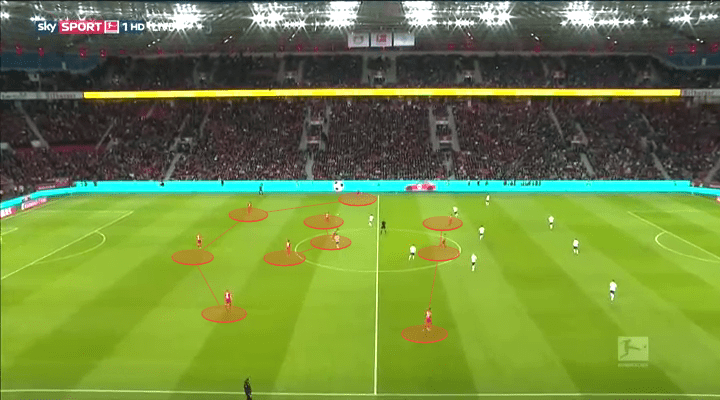
Using the 4-3-3, he tends to do rotations upfront, and the central forward, in most cases Osako, would have a false nine role and drop deeper to help with the build-up. He also does late runs into the box.
The Japanese’s technical abilities and spatial awareness fit Kohfeldt’s vision perfectly, and he turned out to be a good replacement of the team’s ex-star, Max Kruse.
The coach also set the team up in 4-2-3-1, 4-3-1-2, and 4-4-2, but he seems to have struggled to find the right balance using these schemes.
The results might not show it, but the 37-year-old has a rare clear vision of what he wants to see on the pitch.
Although the players do not always successfully implement his strategy, his approach is evident in every movement.
Their opponents most frequently use a 4-4-2 or 4-2-3-1 formation, mainly using their midfield to trouble Werder’s build-up.
Florian Kohfeldt Build-up and passing efforts
Under Florian Kohfeldt’s tactics, Werder tends to build up from the back and play possession football.
When in control, they mostly used the centre-backs as a starting point, who then spread out to the highly positioned full-backs.
The keeper is also regularly involved as an option for retaining possession and forming triangular pass combinations with the central defenders.
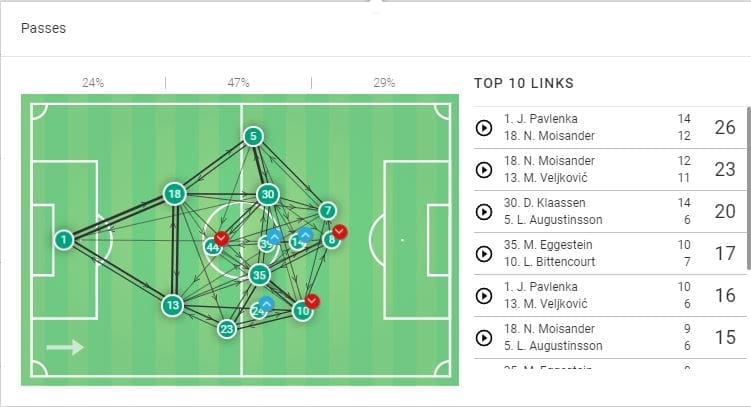
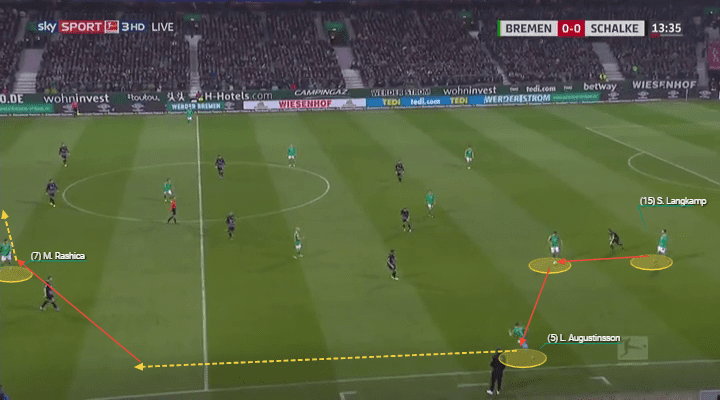
They prefer using the left flank for delivering the ball to the more advanced areas, where Rashica would often drop midway to help with the ball distribution.
The centre-midfielders would position in a way to provide more central passing options, often using Şahin’s playmaking abilities to distribute the ball further.
Their strength lies in their ability to use both the flanks and the central areas to attack through.
The team often overloads the central areas in the opposition half and uses off-the-ball movement to create opportunities.
When playing against teams that apply a high press and their build-up is troubled, they tend to use long balls and chipped passes to bypass the press.
They would send long balls in between the opposition’s midfield and defensive line and use late runs into the box to expose the defence.
In such a case, the whole defensive line would move out from their mid-block and position lower in their half, bringing the full-backs back.
Another pattern seen against teams that apply more pressure is that Werder’s frontline pulls back to the central line in order to pick up the ball and do combinations in an effort to break the opposition’s defensive structure.
The German side likes to play possession football using short-pass combinations.
They do 412.4 passes per game with 82.8% accuracy but tend to struggle against teams that match their approach and impose their own pace.
Florian Kohfeldt’s Attacking approach
Although Bremen often uses the flanks to deliver the ball to the final third, they usually rely on centrally-focused attacking play.
As already mentioned, the forward players’ positioning is crucial for their attacking ventures.
No matter if it would be the centre-forward or the wingers that would drop back.
They would often do that not only to pick up the ball and help finish the attacks but also to open space for the midfielder to move around the box and provide deep runs, which Kohfeldt has insisted on including in the team’s attacking strategy.
Die Werderaner rely on the high shot frequency and overloading the opposition’s half, forcing them into mistakes.
Something that the coach wanted to implement, but it did not work out, is increasing their crossing frequency.
Unfortunately, the team’s attempts decreased as well as their accuracy.
That is one of the reasons for their slightly lower efficiency in attack.
In the 2018/19 season, they performed 17.21 crosses per 90 minutes, while in the current season, they sent only 13.13 crosses on average.
It still has not affected their attacking capability a tonne, though.
They create 13 shots per game.
Another feature of their attacking plan is the use of counter-attacks to expose their opponents.
They would use the attackers’ positioning to perform speed counters. Rashica would be the most active contributor, staying midway and waiting to receive the ball if a possibility for a counter occurred.
They perform 3.33 counters per 90 on average.
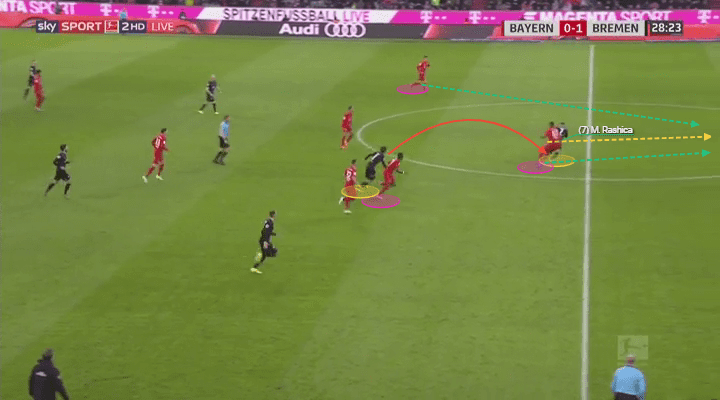
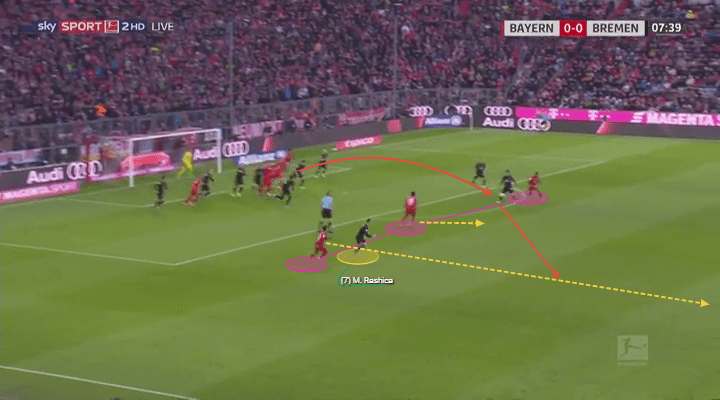
Florian Kohfeldt’s Defensive Strategy
The team’s defensive performance seems to be the reason for its struggles this season.
That’s what takes away from its overall straightforward strategy.
This can be seen only from the goals conceded on average this season (2.33) compared to last season (1.44).
Although there could be some improvements in their defending during possession phases, some other issues have resulted in poor-ish results.
They have decreased the number of their back passes and long passes, which is proof that they have found a better way to keep possession and bypass the press.
They mostly use lateral passes, although they often get stuck in midfield for too long.
Kohfeldt has also worked on creating a way to stop the team from conceding counters.
It all starts with the players’ positioning when still in possession.
He prefers committing a few players behind the ball.
The centre-backs would stay in position but would also be supported by the defensive midfield.
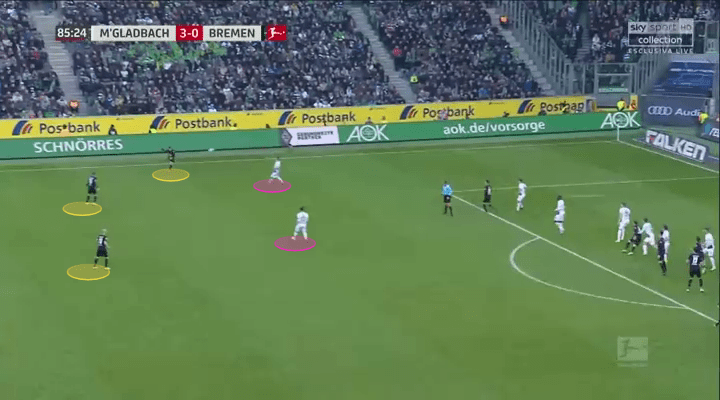
They tend to lose aerial duels in critical areas (mainly around the midfield), which affects their performance during the defensive transition and allows opponents to advance the ball.
However, their success record has improved this term.
As already mentioned, they would switch between mid-block and low-block depending on the opposition.
They would sometimes commit only one of the full-backs further and stay with a back-three when in possession.
They would, though, drop all four defenders back against attack-minded teams.
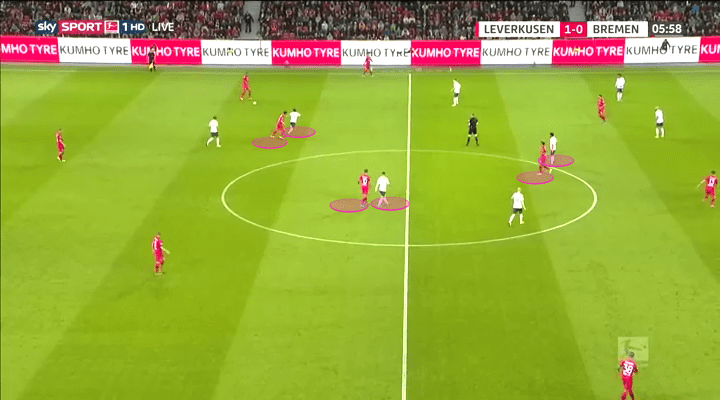
They would change their pressing strategy depending on the opposition’s strengths.
They would either press up high against teams that tend to build up from the back using the central back duo or try to limit the spaces in the midfield and block the passing lanes to stop teams that are creative and use a lot of off-the-ball movement in the central areas.
That is not always the case though as they tend to lose the ball exactly midway and concede goal-scoring opportunities afterwards.
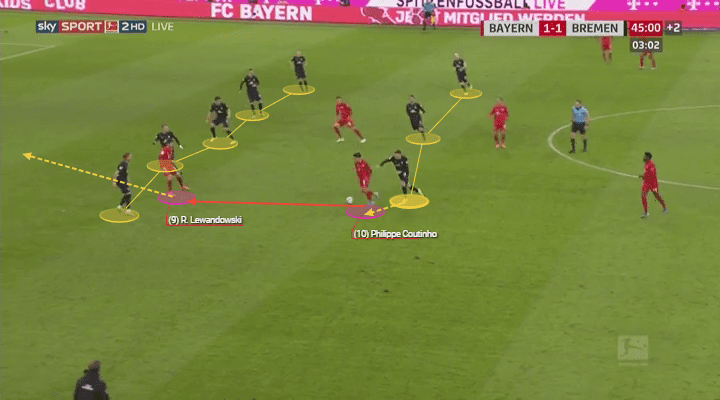
They do fail to defend against teams using lots of off-the-ball movement in and around the box, though.
The backline’s awareness of their opponent’s movement and positioning is often lacking.
Their disturbingly poor performance against Bayern Munich only underlined their main weaknesses.
Most of Bayern’s goals came after a creativity boost and off-the-ball movement in the box, where Werder’s defenders could not react properly and let players sneak behind their backs on a few occasions.
That is a repeating pattern in their defensive actions that costs them a lot.


Their overall performance in defending the box is poor.
They struggle to defend against attack-minded teams and show poor decision-making and positioning when defending set-pieces.
The team
has conceded nine goals from set-pieces this campaign so far.Part of it is their lack of awareness yet again, but they also struggle to win their aerial duels in the box.
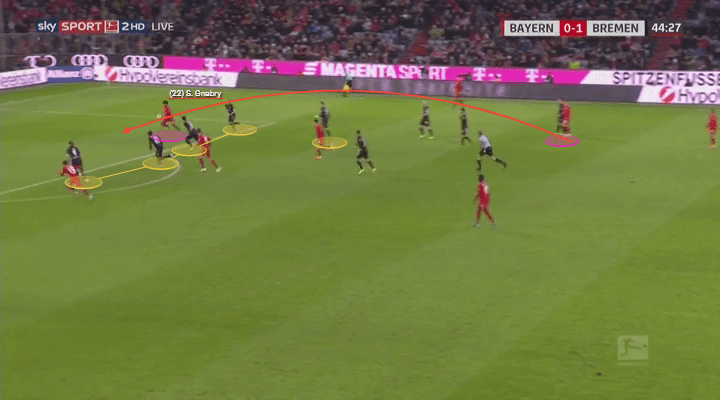
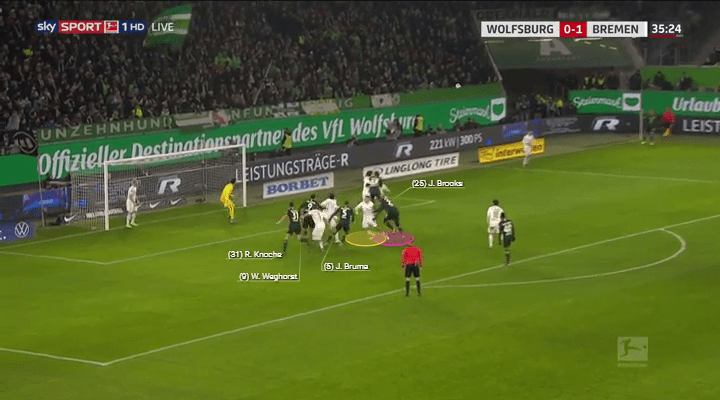
They also apply man-to-man marking when covering the flanks, but they often struggle against teams with higher pace.
This causes chaotic movement in Werder’s players and allows their opponents to attack the wings and use crosses to finish the attack.
As Bremen already mentioned, that is not ideal, and it lacks good positioning and reactions when defending in the box.
Key figures
As mentioned, Osako was put under immense pressure, as his role was to replace Kruse as one of the leading figures in the attack.
Luckily, he did not have to do this on his own, as Werder has quite a few goal-scorers this term.
The leading scorer is Milot Rashica with seven goals and three assists, followed by Osako with four goals.
Davy Klaassen has also contributed with three goals and three assists.
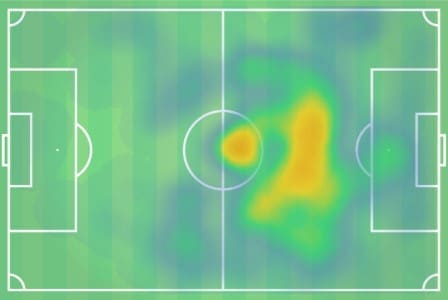
Kohfeldt mainly stuck to last season’s attacking strategy, which involved a lot of movement.
Rashica continues to be a key player, contributing to the build-up but also having a strong attacking flair and being clinical when the team counter-attacks.
Davy Klaassen is responsible for retaining possession and distributing the ball to the more advanced areas.
He is always among the most frequent passing links and contributes on the left flank, but he also tends to cut inside quite often.
He increases the creativity levels in the final third but also contributes with many defensive duels midway, which often allows Werder to regain possession and attack.
His concentration and work under pressure are highly valued, and the team relies heavily on his movement, both up front and back.
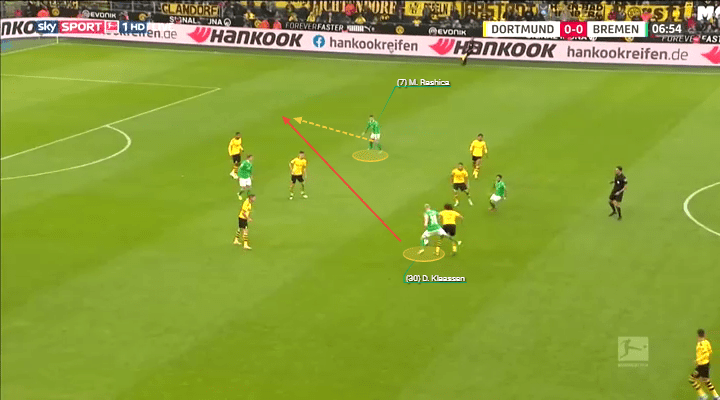
Conclusion
Kohfeldt needs to find a way to improve Werder’s defensive performance; otherwise, it will diminish their potential.
The team’s overall performance and strategy are not shown in their results due to their lack of awareness and good reactions under pressure.
If the coach manages to minimise these mistakes, his tactical flexibility and ability to adjust to his opponent’s strategy could earn the team a better spot.
The 37-year-old’s approach could fit many teams, and there’s no doubt that after gaining some experience, he could be among the new shining stars in the Bundesliga.






Comments